
Dexter Avenue Baptist Church is a Baptist church in Montgomery, Alabama, United States, affiliated with the Progressive National Baptist Convention. The church was designated as a National Historic Landmark in 1974 because of its importance in the civil rights movement and American history. In 1978 the official name was changed to the Dexter Avenue King Memorial Baptist Church, in memory of Dr. Martin Luther King Jr., who was pastor there and helped organize the Montgomery bus boycott in 1955 during the civil rights era. The church is located steps away from the Alabama State Capitol.

First Baptist Congregational Church is a United Church of Christ and Baptist congregation currently located at 60 N. Ashland Blvd. in Chicago, Illinois, United States. The church building is an Illinois Historic Landmark and is listed on the National Register of Historic Places. The building was designed by architect Gurdon P. Randall for the Union Park Congregational Church, founded in 1860, and was built between 1869 and 1871. After the Great Chicago Fire of 1871, the Mayor's Office, City Council, and General Relief Committee of Chicago were temporarily headquartered in the church. In 1910, the building of nearby First Congregational Church burnt down. Union Park Congregational then merged with First Congregational to form (New) First Congregational Church. Two other congregations would eventually merge into the new First Congregational Church: Leavitt Street Congregational Church in 1917 and Bethany Congregational Church in the 1920s.

The West Jackson Boulevard District in Chicago, Illinois, also known as West Jackson Historic District, was listed on the National Register of Historic Places in 1978. It was earlier designed as a Chicago Landmark, in 1976, and expanded as Jackson Boulevard District and Extension in 1997. The NRHP district was expanded in 1989 to include one more building, the James H. Pearson House.

West Union Baptist Church is a Baptist congregation and historic church structure in West Union, Oregon, United States.
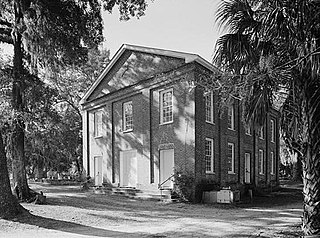
The Penn Center, formerly the Penn School, is an African-American cultural and educational center in the Corners Community, on Saint Helena Island. Founded in 1862 by Quaker and Unitarian missionaries from Pennsylvania, it was the first school founded in the Southern United States specifically for the education of African-Americans. It provided critical educational facilities to Gullah slaves freed after plantation owners fled the island, and continues to fulfill an educational mission. Leigh Richmond Miner photographed students and activities at the school.
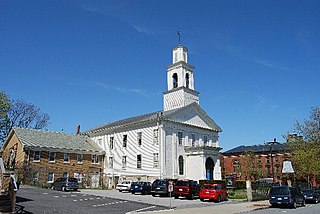
The First Baptist Church is a historic Baptist church meeting house in New Bedford, Massachusetts. The Greek Revival building was constructed in 1829, and has been a prominent landmark of the city ever since. Its tower appears on the city seal.

This is a list of the National Register of Historic Places listings in Detroit, Michigan.
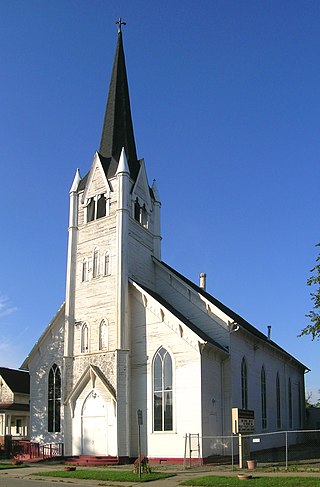
The Gethsemane Evangelical Lutheran Church is a church located at 4461 Twenty-Eighth Street in Detroit, Michigan. It was designated a Michigan State Historic Site in 1980 and listed on the National Register of Historic Places in 1982. The building now houses the Motor City Missionary Baptist Church.
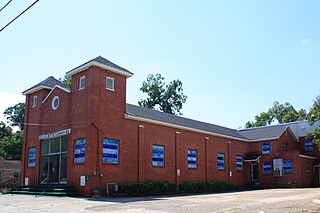
Mt. Olive Missionary Baptist Church No.1 is a historic Missionary Baptist church building in Mobile, Alabama. The church was built in 1916 by the local African American community. It was added to the National Register of Historic Places on May 29, 2008, based on its architectural significance.

The Metropolitan Baptist Church, located at 151 West 128th Street on the corner of Adam Clayton Powell Jr. Boulevard in the Harlem neighborhood of Manhattan, New York City, was originally built in two sections for the New York Presbyterian Church, which moved to the new building from 167 West 111th Street. The chapel and lecture room were built in 1884-85 and were designed by John Rochester Thomas, while the main sanctuary was constructed in 1889-90 and was designed by Richard R. Davis, perhaps following Thomas's unused design. A planned corner tower was never built.

Olive Branch Missionary Baptist Church, also known as Olive Branch Baptist Church, is a historic Baptist church located at Moneta, Bedford County, Virginia, United States. The original section was built about 1896, and expanded about 1920. It is a one-story, "T"-shaped wood-frame building clad in weatherboard siding. It features an original bell tower and Gothic Revival style lancet windows. Adjacent to the church is a contributing cemetery.
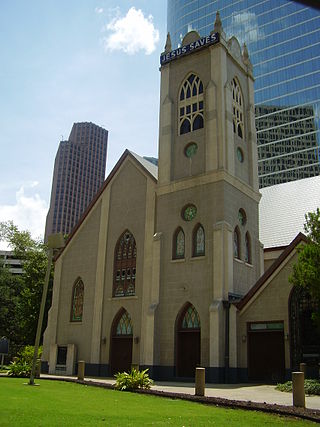
Antioch Missionary Baptist Church is a historic Baptist church at 313 Robin Street in Downtown Houston, Texas. It was historically a part of the Fourth Ward. As of 2012 it was the only remaining piece of the original Fourth Ward east of Interstate 45.

The Old Church, originally known as Calvary Presbyterian Church, is a Carpenter Gothic church located in downtown Portland, Oregon, United States, that is listed on the National Register of Historic Places. Built in 1882, it was designed by Portland architect Warren Heywood Williams. The interior includes stained glass windows made by Portland's Povey Brothers Studio.

Union Park Congregational Church and Carpenter Chapel is a historic church building at 60 N. Ashland Blvd. on the Near West Side of Chicago, Illinois. The chapel is named after Philo Carpenter, a deacon, a co-founder of the congregation and of the Chicago Theological Seminary, and an early donor of the original church who was also a noted abolitionist and the city's first druggist. The two buildings are considered as a unit; together, they are a Chicago Landmark and an Illinois Historic Landmark and are listed on the National Register of Historic Places. The church building is currently occupied by the First Baptist Congregational Church, whose official mailing address is 1613 W. Washington Blvd. in Chicago.
The New Light Missionary Baptist Church was a historic church at 522 Arkansas Street in Helena, Arkansas. It was a two-story wood-frame brick and masonry structure, built in 1917 for an African-American congregation organized in 1894. Its Gothic Revival design bore some resemblance to Helena's Centennial Baptist Church, but this building's architect is not known. Its main facade had a single tall gable, with a three-story tower at the southwest corner. A pair of entrances on the first level were topped by three lancet-style windows in the gable, the center one larger than those flanking it. The interior was simply decorated.
The Little Springs Missionary Baptist Church is a historic church at 4040 Arkansas Highway 58 in Poughkeepsie, Arkansas. Built in 1946, it is built using a distinctive construction method of wood framing finished in stone in a style known as "giraffe rock", in which the exterior is clad in mortared sandstone slabs. The main portion of the church is two stories in height and covered by a gable roof, with a gabled entrance vestibule at the center of the front facade.

The Ebenezer Missionary Baptist Church is a historic church at 4501 S. Vincennes Avenue in the Grand Boulevard community area of Chicago, Illinois. Built in 1899, the building was originally a synagogue for the Isaiah Temple congregation. Architect Dankmar Adler, who partnered with Louis Sullivan to build many of Chicago's early skyscrapers, designed the Neoclassical building; Adler was the son of a rabbi, and he designed several other synagogues in Chicago.

Rutledge, Florida is an unincorporated community in central Alachua County, Florida. The community was established for formerly enslaved persons during Reconstruction by the Freedmen's Bureau. The First Morning Star Missionary Baptist Church and the Greater Liberty Hill United Methodist Church, both founded in the 19th century, continue to serve the community. The Greater Liberty Hill church is the site of the Liberty Hill Schoolhouse, which is on the National Register of Historic Places. The Rutledge Community Cemetery, formerly called Union Cemetery of Rutledge, is under the stewardship of the Second Morning Star Missionary Baptist Church. The center of the community was located about five miles west of Gainesville, Florida in the 19th century. As of 2021 it extends from just west of the Gainesville city limits to I-75. A post office was established in 1886, and closed in 1905. In 1888 the community had three stores and a boarding house. It was on the planned route of the Gainesville, Tallahassee and Western Railroad, which was never built.

















